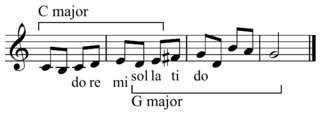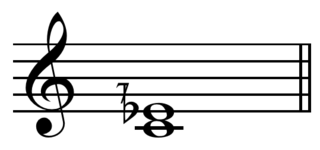
In music, just intonation or pure intonation is the tuning of musical intervals as whole number ratios of frequencies. An interval tuned in this way is said to be pure, and is called a just interval. Just intervals consist of tones from a single harmonic series of an implied fundamental. For example, in the diagram, if the notes G3 and C4 are tuned as members of the harmonic series of the lowest C, their frequencies will be 3 and 4 times the fundamental frequency. The interval ratio between C4 and G3 is therefore 4:3, a just fourth.
In music theory, an interval is a difference in pitch between two sounds. An interval may be described as horizontal, linear, or melodic if it refers to successively sounding tones, such as two adjacent pitches in a melody, and vertical or harmonic if it pertains to simultaneously sounding tones, such as in a chord.
In music theory, the tritone is defined as a musical interval spanning three adjacent whole tones. For instance, the interval from F up to the B above it is a tritone as it can be decomposed into the three adjacent whole tones F–G, G–A, and A–B.
Articles related to music include:
A seventh chord is a chord consisting of a triad plus a note forming an interval of a seventh above the chord's root. When not otherwise specified, a "seventh chord" usually means a dominant seventh chord: a major triad together with a minor seventh. However, a variety of sevenths may be added to a variety of triads, resulting in many different types of seventh chords.

A chord, in music, is any harmonic set of pitches consisting of multiple notes that are sounded simultaneously, or nearly so. For many practical and theoretical purposes, arpeggios and other types of broken chords may also be considered as chords in the right musical context.

In music, modulation is the change from one tonality to another. This may or may not be accompanied by a change in key signature. Modulations articulate or create the structure or form of many pieces, as well as add interest. Treatment of a chord as the tonic for less than a phrase is considered tonicization.
Modulation is the essential part of the art. Without it there is little music, for a piece derives its true beauty not from the large number of fixed modes which it embraces but rather from the subtle fabric of its modulation.

In music theory, limit or harmonic limit is a way of characterizing the harmony found in a piece or genre of music, or the harmonies that can be made using a particular scale. The term limit was introduced by Harry Partch, who used it to give an upper bound on the complexity of harmony; hence the name.

A semitone, also called a half step or a half tone, is the smallest musical interval commonly used in Western tonal music, and it is considered the most dissonant when sounded harmonically. It is defined as the interval between two adjacent notes in a 12-tone scale. For example, C is adjacent to C♯; the interval between them is a semitone.

In music theory, a major chord is a chord that has a root, a major third, and a perfect fifth. When a chord comprises only these three notes, it is called a major triad. For example, the major triad built on C, called a C major triad, has pitches C–E–G:

In music theory, a minor chord is a chord that has a root, a minor third, and a perfect fifth. When a chord comprises only these three notes, it is called a minor triad. For example, the minor triad built on A, called an A minor triad, has pitches A–C-E:

In Western classical music, an augmented fifth is an interval produced by widening a perfect fifth by a chromatic semitone. For instance, the interval from C to G is a perfect fifth, seven semitones wide, and both the intervals from C♭ to G, and from C to G♯ are augmented fifths, spanning eight semitones. Being augmented, it is considered a dissonant interval.

A quarter tone is a pitch halfway between the usual notes of a chromatic scale or an interval about half as wide as a semitone, which itself is half a whole tone. Quarter tones divide the octave by 50 cents each, and have 24 different pitches.
In Western music, the adjectives major and minor may describe an interval, chord, scale, or key. A composition, movement, section, or phrase may also be referred to by its key, including whether that key is major or minor.

In music theory, a comma is a very small interval, the difference resulting from tuning one note two different ways. Strictly speaking, there are only two kinds of comma, the syntonic comma, "the difference between a just major 3rd and four just perfect 5ths less two octaves", and the Pythagorean comma, "the difference between twelve 5ths and seven octaves". The word comma used without qualification refers to the syntonic comma, which can be defined, for instance, as the difference between an F♯ tuned using the D-based Pythagorean tuning system, and another F♯ tuned using the D-based quarter-comma meantone tuning system. Intervals separated by the ratio 81:80 are considered the same note because the 12-note Western chromatic scale does not distinguish Pythagorean intervals from 5-limit intervals in its notation. Other intervals are considered commas because of the enharmonic equivalences of a tuning system. For example, in 53TET, B♭ and A♯ are both approximated by the same interval although they are a septimal kleisma apart.

Otonality and utonality are terms introduced by Harry Partch to describe chords whose pitch classes are the harmonics or subharmonics of a given fixed tone (identity), respectively. For example: 1/1, 2/1, 3/1,... or 1/1, 1/2, 1/3,....
An Otonality is that set of pitches generated by the numerical factors (...identities)...over a numerical constant in the denominator. Conversely, a Utonality is the inversion of an Otonality, a set of pitches with a numerical constant in the numerator over the numerical factors...in the denominator.

In music, 53 equal temperament, called 53 TET, 53 EDO, or 53 ET, is the tempered scale derived by dividing the octave into 53 equal steps. Each step represents a frequency ratio of 21⁄53, or 22.6415 cents, an interval sometimes called the Holdrian comma.

In music, the septimal minor third, also called the subminor third or septimal subminor third, is the musical interval exactly or approximately equal to a 7/6 ratio of frequencies. In terms of cents, it is 267 cents, a quartertone of size 36/35 flatter than a just minor third of 6/5. In 24-tone equal temperament five quarter tones approximate the septimal minor third at 250 cents. A septimal minor third is almost exactly two-ninths of an octave, and thus all divisions of the octave into multiples of nine have an almost perfect match to this interval. The septimal major sixth, 12/7, is the inverse of this interval.

Five-limit tuning, 5-limit tuning, or 5-prime-limit tuning (not to be confused with 5-odd-limit tuning), is any system for tuning a musical instrument that obtains the frequency of each note by multiplying the frequency of a given reference note (the base note) by products of integer powers of 2, 3, or 5 (prime numbers limited to 5 or lower), such as 2−3·31·51 = 15/8.
![]() to B
to B ![]() , such that in moving from one to the other each line shifts less than a half-step. Within a just intonation scale, this could be represented (
, such that in moving from one to the other each line shifts less than a half-step. Within a just intonation scale, this could be represented ( ![]() , indicates an approximate quarter-tone sharp,
, indicates an approximate quarter-tone sharp, ![]() an approximate quarter-tone flat) by
an approximate quarter-tone flat) by














